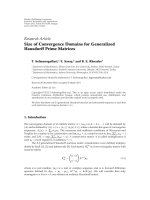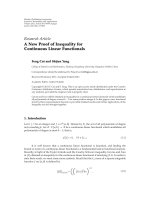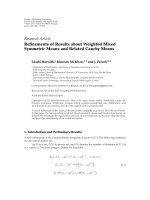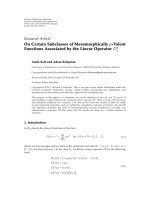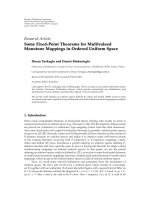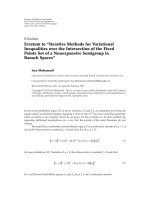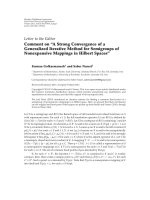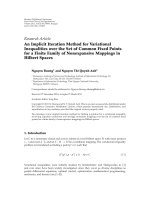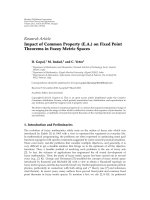Hindawi Publishing Corporation Journal of Inequalities and Applications Volume 2010, Article ID docx
Bạn đang xem bản rút gọn của tài liệu. Xem và tải ngay bản đầy đủ của tài liệu tại đây (484.26 KB, 11 trang )
Hindawi Publishing Corporation
Journal of Inequalities and Applications
Volume 2010, Article ID 175369, 11 pages
doi:10.1155/2010/175369
Research Article
Some Starlikeness Criterions for
Analytic Functions
Gejun Bao,
1
Lifeng Guo,
1
and Yi Ling
2
1
Department of Mathematics, Harbin Institute of Technology, Harbin 150001, China
2
Department of Mathematical Science, Delaware State University, Dover, DE 19901, USA
Correspondence should be addressed to Gejun Bao, and
Yi Ling,
Received 26 October 2010; Accepted 16 December 2010
Academic Editor: Vijay Gupta
Copyright q 2010 Gejun Bao et al. This is an open access article distributed under the Creative
Commons Attribution License, which permits unrestricted use, distribution, and reproduction in
any medium, provided the original work is properly cited.
We determine the condition on α, μ, β,andλ for which |1−αz/fz
μ
αzf
z/fzz/fz
μ
−
1| <λimplies fz ∈ S
∗
β,whereS
∗
β is the class of starlike functions of order β. Some results of
Obradovi
´
c and Owa are extended. We also obtain some new results on starlikeness criterions.
1. Introduction
Let n be a positive integer, and let H
n
denote the class of function
f
z
z
∞
kn
a
k1
z
k1
1.1
that are analytic in the unit disk U {z : |z| < 1}. For 0 ≤ β<1, let
S
∗
β
f ∈ H
1
:Re
zf
z
f
z
>β, z∈ U
1.2
denote the class of starlike function of order β and S
∗
0S
∗
.
Let fz and Fz be analytic in U; then we say that the function fz is subordinate
to Fz in U, if there exists an analytic function wz in U such that |wz|≤|z|,andfz ≡
Fwz, denoted that f ≺ F or fz ≺ Fz.IfFz is univalent in U, then the subordination
is equivalent to f0F0 and fU ⊂ FU1.
2 Journal of Inequalities and Applications
Let
S
λ
f ∈ H
1
:
f
z
− 1
<λ,z∈ U
. 1.3
Singh 2 proved that S
λ
⊂ S
∗
if 0 <λ≤ 2/
√
5. More recently, Fournier 3, 4 proved that
S
λ
⊂ S
∗
⇐⇒ 0 ≤ λ ≤
2
√
5
,
ρ
λ
⎧
⎪
⎪
⎪
⎪
⎨
⎪
⎪
⎪
⎪
⎩
1 − λ
1 − λ/2
1 − λ
2
/4
, if 0 ≤ λ ≤
2
3
,
1/2
1 −
5/4
λ
2
1 − λ
2
/4
, if
2
3
≤ λ ≤ 1,
1.4
is the order of starlikeness of S
λ
.Now,wedefine
U
λ, μ, n
f ∈ H
n
:
zf
z
f
z
z
f
z
μ
− 1
<λ, z∈ U
.
1.5
Clearly, Uλ, −1, 1S
λ
. In 1998, Obradovi
´
c 5 proved that
U
λ, μ, 1
⊂ S
∗
1.6
if 0 <μ<1and0<λ≤ 1 − μ/
1 − μ
2
μ
2
. Recently, Obradovi
´
candOwa6 proved that
U
λ, μ, n
⊂ S
∗
1.7
if 0 <μ<1and0<λ≤ n − μ/
n − μ
2
μ
2
.
In this paper we find a condition on α, μ, β,andλ for which
1 − α
z
f
z
μ
α
zf
z
f
z
z
f
z
μ
− 1
<λ
1.8
implies fz ∈ S
∗
β and extend some results of Obradovi
´
candOwa5, 6. Also, we obtain
some new results on starlikeness criterions.
Journal of Inequalities and Applications 3
2. Main Results
For our results we need the following lemma.
Lemma 2.1 see 6. Let pz1 p
n
z
n
p
n1
z
n1
··· be analytic in U, n ≥ 1, and satisfy the
condition
p
z
−
1
μ
zp
z
≺ 1 λz, 0 <μ<1, 0 <λ≤ 1.
2.1
Then
p
z
≺ 1 λ
1
z, 2.2
where
λ
1
λμ
n − μ
.
2.3
Theorem 2.2. Let 0 ≤ μ<1, nα > μ, 0 ≤ β<1, and
M
n
α, β, μ
⎧
⎪
⎪
⎪
⎪
⎪
⎪
⎪
⎪
⎪
⎪
⎪
⎪
⎪
⎪
⎪
⎪
⎨
⎪
⎪
⎪
⎪
⎪
⎪
⎪
⎪
⎪
⎪
⎪
⎪
⎪
⎪
⎪
⎪
⎩
α
nα − μ
1 − β
α
n μ − μβ
− 2μ
, if α ≥ α
2
,
nα − μ
2α
1 − β
− 1
n
2
α
2
2
μ
2
1 − β
− nμ
α
, if α
1
<α<α
2
,
nα − μ
1 − β
n − μ
1 − β
, if 0 <α≤ α
1
,
2.4
where
α
1
n − μ
1 − β
n
1 − β
,
α
2
n 3μ
1 − β
n 3μ
1 − β
2
− 8nμ
1 − β
2n
1 − β
.
2.5
If pz1 p
n
z
n
p
n1
z
n1
··· and qz1 q
n
z
n
q
n1
z
n1
··· are analytic in U, satisfy
q
z
≺ 1
μλ
nα − μ
z,
2.6
q
z
1 − α αp
z
≺ 1 λz, 2.7
4 Journal of Inequalities and Applications
where 0 <λ≤ M
n
α, β, μ,then
Re p
z
>β, for z ∈ U. 2.8
Proof. If μ 0, it is easy to see the result is true. Now, assume μ>0. Let
N
μλ
nα − μ
.
2.9
If there exists z
0
∈ U, such that Re pz
0
β, then we will show that
q
z
0
1 − α αp
z
0
− 1
≥ λ 2.10
for 0 <λ≤ M
n
α, β, μ.Notethat|qz
0
− 1|≤N for z ∈ U;itissufficient to show that
α
p
z
0
− 1
− N
1 − α αp
z
0
≥ λ 2.11
for 0 <λ≤ M
n
α, β, μ.Letpz
0
β iy, y ∈ R; then, the left-hand side of 2.11 is
α
β − 1
2
y
2
− N
αβ 1 − α
2
α
2
y
2
α
β
2
y
2
1 − 2β − N
α
2
β
2
α
2
y
2
2α
1 − α
β
1 − α
2
.
2.12
Suppose that x β
2
y
2
and note that nα −μN μλ; then inequality 2.11 is equivalent to
N ≤
αμ
x 1 − 2β
nα − μ μ
α
2
x 2α
1 − α
β
1 − α
2
2.13
for all x ≥ β
2
and 0 <λ≤ M
n
α, β, μ. Now, if we define
ϕ
x
x 1 −2β
nα − μ μ
α
2
x 2α
1 − α
β
1 − α
2
,x≥ β
2
,
2.14
then we have
ϕ
x
nα − μ
ψ
x
μ
1 − 2α
1 − β
2ψ
x
x 1 −2β
nα − μ
μψ
x
2
,x>β
2
,
2.15
where
ψ
x
α
2
x 2α
1 − α
β
1 − α
2
.
2.16
Journal of Inequalities and Applications 5
Since
ψ
x
α
2
x
2
2α
1 − α
β
1 − α
2
>
1 − α
1 − β
, for x>β
2
,
2.17
the denominator of ϕ
x is positive. Further, let
T
x
nα − μ
ψ
x
μ
1 − 2α
1 − β
,x≥ β
2
.
2.18
We have
T
x
≥
nα − μ
1 − α
1 − β
μ
1 − 2α
1 − β
. 2.19
If
1
1 − β
≤ α,
2.20
we get
T
x
≥ nα
2
1 − β
−
n 3μ
1 − β
α 2μ
n
1 − β
α − r
1
α − r
2
,
2.21
where
r
1
n 3μ
1 − β
−
n 3μ
1 − β
2
− 8nμ
1 − β
2n
1 − β
,
r
2
n 3μ
1 − β
n 3μ
1 − β
2
− 8nμ
1 − β
2n
1 − β
.
2.22
Note that
r
1
<
1
1 − β
<r
2
.
2.23
We obtain
T
x
≥ 0forα ≥ α
2
r
2
. 2.24
If
1
2
1 − β
≤ α<
1
1 − β
,
2.25
6 Journal of Inequalities and Applications
we have
T
x
≥ α
n − μ
1 − β
− n
1 − β
α
. 2.26
Hence we obtain
T
x
≥ 0for
1
2
1 − β
≤ α ≤ α
1
,
2.27
where
α
1
n − μ
1 − β
n
1 − β
<
1
1 − β
. 2.28
If
0 <α<
1
2
1 − β
,
2.29
we have 1 − 2α1 − β > 0. It follows that Tx > 0.
Therefore we obtain ϕ
x ≥ 0forx>β
2
if 0 <α≤ α
1
or α ≥ α
2
. It follows that
min
x≥β
2
ϕ
x
ϕ
β
2
⎧
⎪
⎪
⎪
⎪
⎨
⎪
⎪
⎪
⎪
⎩
1 − β
α
n μ − μβ
− 2μ
, if α ≥ α
2
,
1 − β
α
n − μ
1 − β
, if 0 <α≤ α
1
.
2.30
If α
1
<α<α
2
, we have
lim
x →
β
2
T
x
T
β
2
nα − μ
1 − α
1 − β
μ
1 − 2α
1 − β
< 0
2.31
by 2.13 and 2.21 for 1/1 −β ≤ α<α
2
and by 2.23 for α
1
<α<1/1 −β.NotethatTx
is an continuous increasing function for x ≥ β
2
,and
lim
x →∞
T
x
> 0.
2.32
Then there exists a unique x
0
∈ β
2
, ∞, such that
T
x
0
0, or ϕ
x
0
0. 2.33
Thus, x
0
is the global minimum point of ϕx on β
2
, ∞. It follows from 2.33 that
nα − μ
α
2
x
0
2α
1 − α
β
1 − α
2
μ
2α
1 − β
− 1
,
2.34
Journal of Inequalities and Applications 7
or
x
0
1
α
2
μ
2
2α
1 − β
− 1
2
nα − μ
2
− 2α
1 − α
β −
1 − α
2
. 2.35
By a simple calculation, we may obtain
min
x≥β
2
ϕ
x
ϕ
x
0
2α
1 − β
− 1
α
n
2
α
2
2
μ
2
1 − β
− nμ
α
2.36
for α
1
<α<α
2
. It follows from 2.30 and 2.36 that that inequality 2.13 holds. This shows
that inequality 2.10 holds, which contradicts with 2.7. Hence we must have
Re p
z
>β, z∈ U. 2.37
Theorem 2.3. Let α, μ, β, λ and M
n
α, β, μ be defined as in Theorem 2.2.Iffz ∈ H
n
satisfies
1 − α
z
f
z
μ
α
zf
z
f
z
z
f
z
μ
− 1
<λ,
2.38
where 0 <λ≤ M
n
α, β, μ,thenfz ∈ S
∗
β.
Proof. If μ 0, M
n
α, β, 0α1 − β and the result is trivial. Now, assume μ>0. If we put
q
z
z
f
z
μ
,
2.39
then by some transformations and 2.38 we get
q
z
−
α
μ
zq
z
≺ 1 λz.
2.40
By Lemma 2.1,weobtain
q
z
≺ 1
μλ
nα − μ
z.
2.41
Let
p
z
zf
z
f
z
.
2.42
8 Journal of Inequalities and Applications
Then we have
q
z
1 − α αp
z
≺ 1 λz. 2.43
By Theorem 2.2,weget
Re p
z
>β, z∈ U. 2.44
It follows that fz ∈ S
∗
β.
For β 0, we get the following corollary.
Corollary 2.4. Let 0 ≤ μ<1, nα > μ, and let
M
n
α, μ
⎧
⎪
⎪
⎪
⎪
⎪
⎪
⎪
⎪
⎪
⎪
⎪
⎪
⎪
⎪
⎨
⎪
⎪
⎪
⎪
⎪
⎪
⎪
⎪
⎪
⎪
⎪
⎪
⎪
⎪
⎩
α
nα − μ
α
n μ
− 2μ
, if α ≥ α
2
,
nα − μ
√
2α − 1
n
2
α
2
2
μ
2
− nμ
α
, if α
1
≤ α<α
2
,
nα − μ
n − μ
, if 0 <α<α
1
,
2.45
where
α
1
n − μ
n
,
α
2
n 3μ
n 3μ
2
− 8nμ
2n
.
2.46
If fz ∈ H
n
satisfies
1 − α
z
f
z
μ
α
zf
z
f
z
z
f
z
μ
− 1
<λ,
2.47
where 0 <λ≤ M
n
α, μ,thenfz ∈ S
∗
.
Corollary 2.5. Let 0 ≤ μ<1, 0 ≤ β<1, and let
M
n
β, μ
⎧
⎪
⎪
⎪
⎪
⎪
⎪
⎨
⎪
⎪
⎪
⎪
⎪
⎪
⎩
n − μ
1 − β
n − μ
1 β
, if 1 >β≥
μ
n μ
,
n − μ
1 − 2β
n
2
2
μ
2
1 − β
− nμ
, if 0 ≤ β<
μ
n μ
.
2.48
Journal of Inequalities and Applications 9
If fz ∈ H
n
satisfies
zf
z
f
z
z
f
z
μ
− 1
<λ,
2.49
where 0 <λ≤ M
n
β, μ,thenfz ∈ S
∗
β.
Proof. Note that
α
1
n − μ
1 − β
n
1 − β
≥ 1, for β ≥
μ
n μ
,
α
1
n − μ
1 − β
n
1 − β
< 1, for β<
μ
n μ
,
α
2
n 3μ
1 − β
n 3μ
1 − β
2
− 8nμ
1 − β
2n
1 − β
≥ 1.
2.50
Putting α 1inTheorem 2.3, we obtain the above corollary.
Remark 2.6. Our results extend the results given by Obradovi
´
c 5, and Obradovi
´
c and Owa
6.
Theorem 2.7. Let 0 <μ<1, 0 ≤ β<1, Re{c} > −μ, and let
β
n
β, μ
⎧
⎪
⎪
⎪
⎪
⎪
⎪
⎨
⎪
⎪
⎪
⎪
⎪
⎪
⎩
n − μ
1 − β
n c −μ
n − μ
1 − β
c − μ
, if β ≥
μ
n μ
,
n − μ
1 − 2β
n c −μ
n
2
2
μ
2
1 − β
− nμ
c − μ
, if β<
μ
n μ
.
2.51
If fz ∈ H
n
satisfies
zf
z
f
z
z
f
z
μ
− 1
<λ,
2.52
where 0 <λ≤ β
n
β, μ, and
F
z
z
c − μ
z
c−μ
z
0
t
f
t
μ
t
c−μ−1
dt
−1/μ
,
2.53
then Fz ∈ S
∗
β.
10 Journal of Inequalities and Applications
Proof. Let
Q
z
F
z
z
F
z
1μ
.
2.54
Then from 2.52 and 2.53 we obtain
Q
z
1
c − μ
Q
z
f
z
z
f
z
1μ
≺ 1 λz.
2.55
Hence, by using Theorem 1 given by Hallenbeck and Ruscheweyh 7, we have that
Q
z
≺ 1 λ
1
z, λ
1
c − μ
λ
n c −μ
z, 2.56
and the desired result easily follows from Corollary 2.5.
For c μ 1, we have the following corollary.
Corollary 2.8. Let 0 <μ<1, 0 ≤ β<1, and let
β
n
β, μ
⎧
⎪
⎪
⎪
⎪
⎪
⎪
⎨
⎪
⎪
⎪
⎪
⎪
⎪
⎩
n − μ
1 − β
n 1
n − μ
1 − β
, if 1 >β≥
μ
n μ
,
n − μ
1 − 2β
n 1
n
2
2
μ
2
1 − β
− nμ
, if 0 ≤ β<
μ
n μ
.
2.57
If fz ∈ H
n
satisfies
zf
z
f
z
z
f
z
μ
− 1
<λ,
2.58
where 0 <λ≤ β
n
β, μ, and
F
z
z
1
z
z
0
t
f
t
μ
dt
−1/μ
,
2.59
then Fz ∈ S
∗
β.
Acknowledgment
The authors would like to thank the referee for giving them thoughtful suggestions which
greatly improved the presentation of the paper. Bao Gejun was supported by NSF of
P.R.China no. 11071048.
Journal of Inequalities and Applications 11
References
1 C. Pommerenke, Univalent Functions with a Chapter on Quadratic Differentials by Gerd Jensen,vol.20of
Studia Mathematica/Mathematische Lehrb
¨
ucher, Vandenhoeck & Ruprecht, G
¨
ottingen, Germany, 1975.
2 V. Singh, “Univalent functions with bounded derivative in the unit disc,” Indian Journal of Pure and
Applied Mathematics, vol. 8, no. 11, pp. 1370–1377, 1977.
3 R. Fournier, “On integrals of bounded analytic functions in the closed unit disc,” Complex Variables.
Theory and Application, vol. 11, no. 2, pp. 125–133, 1989.
4 R. Fournier, “The range of a continuous linear functional over a class of functions defined by
subordination,” Glasgow Mathematical Journal, vol. 32, no. 3, pp. 381–387, 1990.
5 M. Obradovi
´
c, “A class of univalent functions,” Hokkaido Mathematical Journal, vol. 27, no. 2, pp. 329–
335, 1998.
6 M. Obradovi
´
c and S. Owa, “Some sufficient conditions for strongly starlikeness,” International Journal
of Mathematics and Mathematical Sciences, vol. 24, no. 9, pp. 643–647, 2000.
7 D. J. Hallenbeck and S. Ruscheweyh, “Subordination by convex functions,” Proceedings of the American
Mathematical Society, vol. 52, pp. 191–195, 1975.
